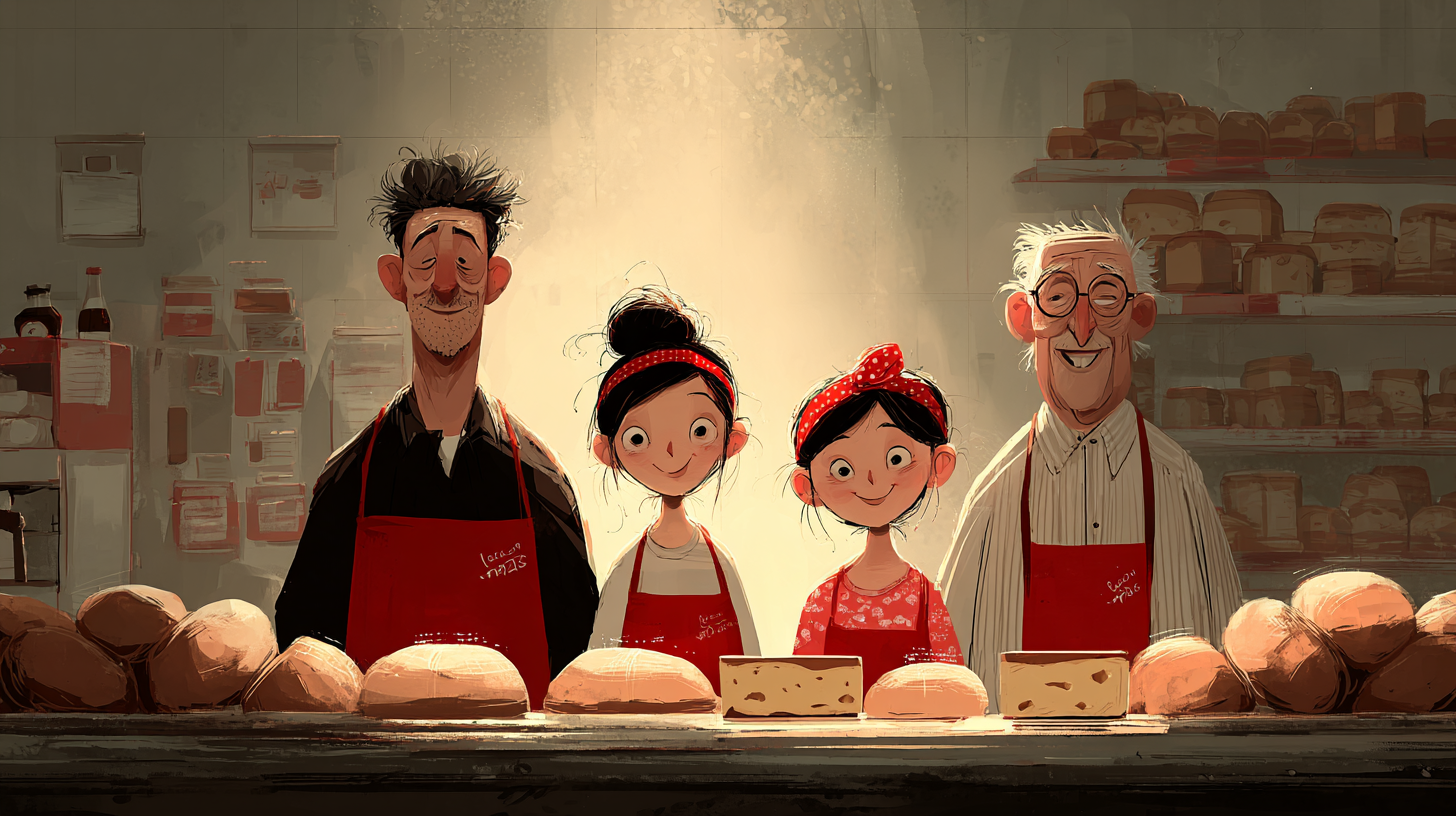“Cheese” means food made from milk, or to smile in a casual way.
「cheese」は牛乳から作る食べ物、または「笑顔になる」という意味のスラング。
以下は英単語 “cheese” に関するストーリー型学習コンテンツです。まずは大枠の意味を理解して最後の文章で確認しましょう。
主な意味(main meaning)
| 品詞 | 意味 | 発音記号 (IPA) | 例文 |
|---|---|---|---|
| 名詞 | 牛乳から作られる食べ物(チーズ) | /tʃiːz/ | I bought some cheese for the sandwich. |
| 動詞 | にっこり笑う(くだけた表現) | /tʃiːz/ | She cheesed for the camera. |
語源(etymology)
「cheese」は古英語 cēse から来ており、さらにラテン語 caseus(カセウス:チーズ)に由来する。
核となるイメージは「固めたミルクの食べ物」。
類義語(synonyms)
| 類義語 | 例文 |
|---|---|
| dairy product | Yogurt is also a popular dairy product. |
| curd | The curd was used to make traditional cheese. |
| smile (動詞の意味で) | She smiled brightly at her friend. |
| grin | He gave a big grin when he saw the cake. |
反義語(antonyms)
| 反義語 | 例文 |
|---|---|
| meat | He prefers meat to cheese in his meals. |
| frown (動詞の意味で) | She frowned when she heard the bad news. |
コロケーション(collocations)
| コロケーション | 例文 |
|---|---|
| cheese sandwich | I had a cheese sandwich for lunch. |
| cream cheese | She spread cream cheese on the bagel. |
| cheese factory | They visited a cheese factory on the school trip. |
| cheese and wine | We enjoyed cheese and wine at the party. |
2項表現(binomials)
| 2項表現 | 例文 |
|---|---|
| bread and cheese | He ate bread and cheese for breakfast. |
| wine and cheese | They hosted a wine and cheese evening. |
英語ストーリー(english story)
The Cheese Factory Visit
Last summer, my English class went on a trip to a cheese factory. Everyone was excited because we all loved cheese sandwiches and cream cheese on bagels. Our teacher said it would be a good chance to see how dairy products like cheese are made.
When we arrived, a guide welcomed us with a big grin (にっこり笑う). He asked us to “say cheese” for a group photo. We all smiled brightly, and the photo looked great. After that, the guide took us into the factory.
Inside, we saw milk being heated and turned into curd. The guide explained that curd is the first step in making cheese. He showed us big machines that pressed the curd and removed water. Finally, the curd became solid cheese. Some of us frowned (しかめっ面をする) when we smelled the strong cheese, but others said it was delicious.
Later, we went to a tasting room. There were many kinds of cheese: soft cheese, hard cheese, and even blue cheese. I preferred cream cheese because it was mild and smooth. My friend Ken said, “Bread and cheese is the best combination.” Another student said, “No, wine and cheese is even better, but maybe we need to wait until we are older!” Everyone laughed.
The guide also talked about the history of cheese. He said the word comes from the Latin word “caseus.” That was interesting because we realized cheese has been eaten for thousands of years.
After the visit, we all sat outside and had lunch. I ate a cheese sandwich with tomatoes. It was simple but tasty. Some students chose meat sandwiches instead, but most of us agreed that cheese was healthier and just as satisfying.
On the way back to school, we talked about our favorite moments. For me, the best part was learning new words like “curd” and “dairy product.” It made me realize that English is not only in books but also in everyday things like food.
That trip taught us that language learning can be fun when we connect it with real-life experiences. From now on, every time I eat cheese, I will remember the factory, the guide’s big grin, and the photo where we all said “cheese.”
和訳
チーズ工場見学
去年の夏、私たちの英語のクラスはチーズ工場へ見学に行きました。みんなチーズサンドイッチ(cheese sandwich)やベーグルに塗るクリームチーズ(cream cheese)が大好きなので、とても楽しみにしていました。先生は「チーズのような乳製品(dairy product)がどう作られるかを見る良い機会だ」と言いました。
工場に着くと、案内人が大きな笑顔(grin)で迎えてくれました。そして「はい、チーズ!(say cheese)」と言って集合写真を撮りました。みんな明るく笑顔(smile)になり、写真はとてもよく撮れました。そのあと案内人が工場の中を見せてくれました。
中では、牛乳が温められ、カード(curd:凝乳)に変わるのを見ました。案内人は「カードはチーズ作りの最初のステップです」と説明しました。大きな機械がカードを押して水分を取り除き、やがて固いチーズになりました。強いチーズの匂いに顔をしかめる(frown)人もいましたが、「おいしい」と言う人もいました。
その後、試食室に行きました。そこにはたくさんの種類のチーズがありました。柔らかいチーズ、固いチーズ、ブルーチーズまでありました。私はやわらかくてなめらかなクリームチーズが一番好きでした。友達のケンは「パンとチーズ(bread and cheese)は最高の組み合わせだ」と言いました。別の生徒は「いや、ワインとチーズ(wine and cheese)の方がいい。でも僕たちは大人になるまで待たないとね」と言いました。みんな笑いました。
案内人はチーズの歴史についても話してくれました。チーズという言葉はラテン語の“caseus”から来ているそうです。私たちはチーズが何千年も前から食べられていると知って、とても面白いと思いました。
見学の後、私たちは外に座ってお昼ご飯を食べました。私はトマト入りのチーズサンドイッチを食べました。シンプルですがとても美味しかったです。肉(meat)のサンドイッチを選んだ生徒もいましたが、ほとんどの人は「チーズの方がヘルシーで同じくらい満足できる」と言いました。
帰り道、私たちは好きな場面について話しました。私にとって一番よかったのは、「curd」や「dairy product」のような新しい単語を学んだことです。それで、英語は本だけでなく、食べ物のような日常のことにもあると気づきました。
この旅行を通して、実際の体験とつなげることで言葉の学習がもっと楽しくなると学びました。これからチーズを食べるたびに、工場のこと、案内人の大きな笑顔(grin)、そして「はい、チーズ」と言って撮った写真を思い出すでしょう。
Q&A
Q: 「cheese」と「dairy product」の違いは何ですか?
A: 「cheese」は牛乳から作られる特定の食べ物(チーズ)を指します。一方「dairy product」は牛乳から作られる食べ物全体を表します。つまり「cheese」は「dairy product」の一つです。
Q: 「cheese」と「curd」の違いは何ですか?
A: 「curd」はチーズを作る途中でできる固まった牛乳のことです。チーズの原料段階のものなので、「curd」から「cheese」が作られると考えると分かりやすいです。
Q: 「cheese」と「smile」の違いは何ですか?
A: 「cheese」は食べ物の意味が基本ですが、スラングで「笑顔になる」という意味もあります。「smile」は一般的な「笑顔を見せる」という意味で、日常会話でもよく使います。「cheese」は写真を撮るときに「はい、チーズ」と言うときなど限定的に使います。
Q: 「cheese」と「grin」の違いは何ですか?
A: 「smile」は普通の笑顔ですが、「grin」は歯を見せて大きく笑うことです。「cheese」の動詞の意味は「smile」に近いので、「grin」ほど大げさな笑いではありません。
Q: 「cheese」と「meat」の違いは何ですか?
A: 「cheese」は牛乳から作られる食べ物ですが、「meat」は動物のお肉を指します。どちらも食べ物ですが、由来が全く違います。
Q: 「cheese sandwich」と「meat sandwich」の違いは何ですか?
A: 「cheese sandwich」はチーズをはさんだサンドイッチで、「meat sandwich」は肉をはさんだサンドイッチです。材料が違うだけで、料理の形は同じです。
Q: 「cheese sandwich」と「cream cheese」の違いは何ですか?
A: 「cheese sandwich」はサンドイッチの種類を表します。一方「cream cheese」は柔らかい種類のチーズそのものを指します。「cream cheese」をパンに塗って「cheese sandwich」にすることもできます。
Q: 「cheese factory」と「cheese sandwich」の違いは何ですか?
A: 「cheese factory」はチーズを作る工場のことです。「cheese sandwich」はチーズを使ったサンドイッチのことです。前者は場所、後者は食べ物を表します。
Q: 「bread and cheese」と「wine and cheese」の違いは何ですか?
A: どちらも「チーズ」とよく組み合わせて使う表現です。「bread and cheese」は日常的でシンプルな食べ方を表し、「wine and cheese」は大人のパーティーや特別な場面での組み合わせを表します。



コメント